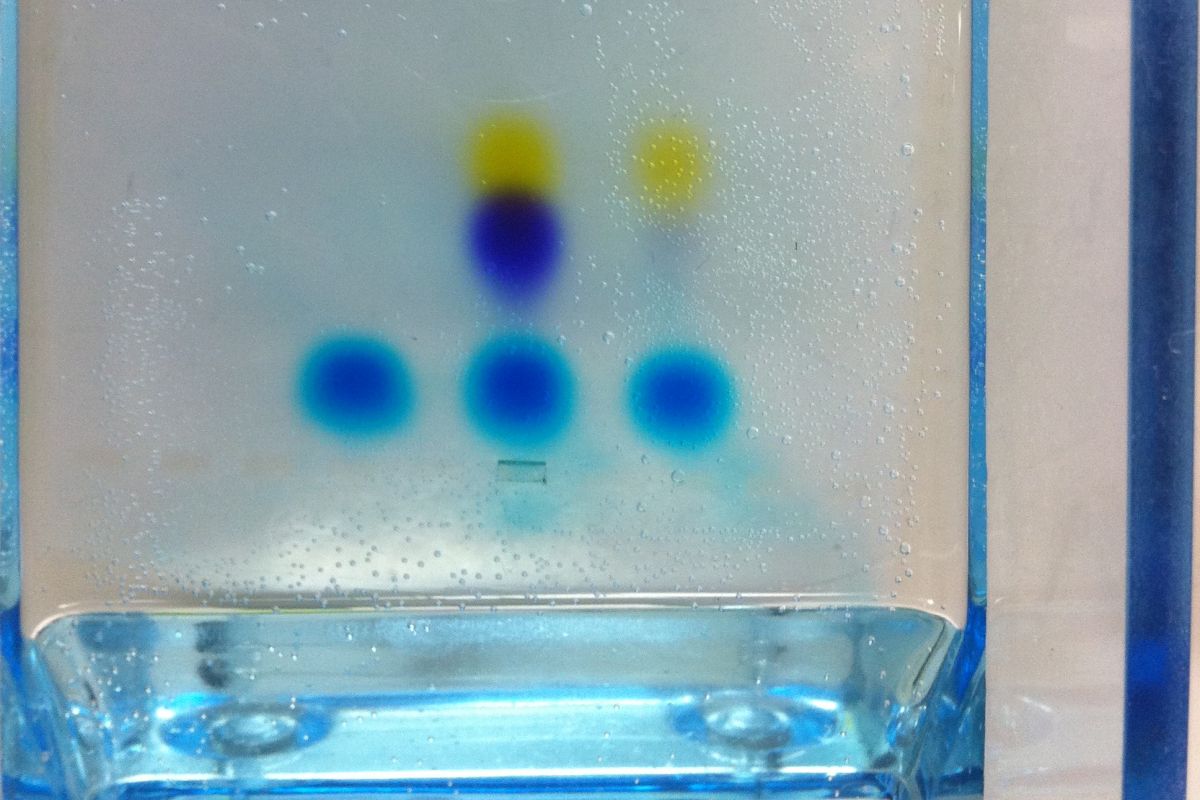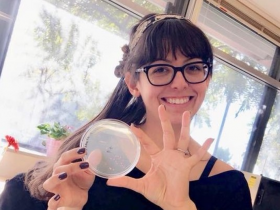
Career Profile
Ashley Young:
A 360-Degree View of Biotech Education
The future of science education is bright. With more research backing the importance of inquiry-based learning, where the teacher is a facilitator not a lecturer, the students are increasingly actively addressing important questions. That combined with new technologies is bringing quality science content to more teachers and learners. And that is so exciting to see.
Of the more than 800,000 students who have participated in the Amgen Biotech Experience (ABE) over the past 30 years, one alumna has defined her career around the experience like no other. First an ABE student and then an ABE teacher, Ashley Young now oversees ABE as program manager for science education at the Amgen Foundation—giving her a unique, 360-degree view of biotech education. But had you told her in high school where she would land, Young would not have believed it.
“It’s totally unreal,” she says. “In high school, I knew about becoming a doctor or nurse, but I really didn’t know about all the different career paths out there.”
ABE spoke with Young about her path from science to education to industry, advice she has now for current students, and her thoughts on the future.
How did you first become interested in science?
As a child, I grew up in a military family. My dad is in the U.S. Marine Corps, so we moved around the US a lot. We lived in Hawaii, we lived in Monterey Bay, we lived in Seattle Washington, to name a few—so we had a lot of opportunities to hike and swim and go camping. We would also visit a lot of science centers and museums, like the great aquarium in Monterey Bay. I got interested in animals, like my mom, who grew up with a lot of different pets. I remember distinctly an elementary school presentation that I did where I dressed up as Jane Goodall with cute little chimpanzee stuffed animals.
What can you tell us about your high school experience, especially in science?
I attended two high schools, and both of them had a pretty good selection of science classes. In the 10th grade, I was in this vocational school program that had a focus on physiology and healthcare. So, it was a half-day class during the school day every other day. The teacher used the time to do activities like simulations of what a nurse or a doctor would be doing. We did this one lab where everyone put a special lotion on their hands to simulate bacteria under UV light, and then we washed our hands in different ways and for different amounts of time to compare methods. We also practiced writing medical shorthand, which was interesting and fun to have real practical experience.
Is that what opened your eyes to the biosciences?
Yes, that drew me to take more elective science classes. AP bio was my favorite. I remember reading in a textbook one night about how if you were to string out all of the DNA from one human cell how long it would reach, and it just blew my mind. I wanted to learn more about DNA. And then I started reading books about viruses and the hot zones, and that got me interested in genetics and biotech.
In my AP bio class in 12th grade in Los Angeles, my teacher was an ABE teacher, so she brought some of the labs. We did gel electrophoresis, and we grew transformed bacteria. She also followed that up with a genetic counselor coming to talk to us about what her job was like. And it was really cool to learn more about those opportunities. Before that, I didn’t know a lot about careers in biotech or the life sciences, besides a wildlife biologist or a doctor. So, that kicked it off!
How did ABE change your life course at that time?
One story comes to mind: I had taken pictures of my gel electrophoresis results with the different color dyes. In my first year of college at UCLA, where I majored in molecular genetics, I started looking for jobs in research labs and really didn’t have much luck. The first interview I got was at a lab doing a lot of molecular genetics, including the basic techniques of gel electrophoresis. I pulled out my phone and showed them that picture to show them that I had done some of those techniques—and that I did them in high school. And since it was so early in my college career, the classes I had taken to that point had not yet been the hands-on labs, so many of my peers had not had the opportunity to touch a pipette or the like. So, I got the job!

What was that first research job like?
When I started working in that molecular genetics lab, I was tasked with the basics like autoclaving glassware, making solutions, and genotyping. I eventually started helping out with gene cloning with bacteria, and then on my own research project looking at protein expression and T-cell development.
So, what eventually led you down the science education path?
In my second year at UCLA, I got involved with CityLab, a group that bused high school students from local LA schools, especially in underserved communities, to campus for a Saturday free of charge to them. CityLab would teach them about a biotech concept and also take them into the lab to do an experience based on a storyline that we would set up.
For example, one of the quarters, we made a film based on the Disney movie, Tangled. We twisted the story so that the students would go into the lab with a sample of Rapunzel’s DNA, as well as that of the king’s and queen’s DNA and the witch who had captured her. So, the students had to help Rapunzel by doing DNA fingerprinting with gel electrophoresis to see if she was the lost princess or not. Each quarter, we’d create these interesting storylines to try to get the high school students interested and into the lab.
That club really changed my perspective from wanting to do research and work in a lab to “wow, there’s so much creativity that you can bring into science education.” I initially had a minor in science education and then got more and more drawn to that area. I got a scholarship through the National Science Foundation, and that helped me afford a master’s degree in education.
So you then taught for a little while?
Yes, I taught for 3 years in San Fernando Valley at the Valley Academy of Arts and Sciences. I taught a lot of different life science classes, including 9th-grade biology, biochemistry, physiology, and AP biology.
As soon as I became a teacher, I worked to figure out where the biotech labs my AP biology teacher did had come from. I re-discovered ABE online and did the weeklong teacher training in the summer. I brought ABE labs to all my classes because I thought it would benefit them no matter what their level. So, I was able to bring ABE to 180 students total, and it was the best part of the year.
What was it like transitioning from teaching into the biotech industry?
I really enjoyed teaching but wanted to explore other options because teaching was no longer feeling sustainable for my work–life balance. So, I made the hard decision to look at other opportunities. I reached out to “Beatrice the Biologist”; she lives in LA and is a former AP biology teacher who now writes books and does these amazing little science comics. She had left teaching and gone into more of a curriculum design and science communications approach, where she still had a chance to impact students.
Based on that conversation, I looked into instructional design and, through a friend in the area, heard about a training position at a biotech company in Santa Monica. I got the job, which supported the different departments in building out their training materials and evaluating how they trained their employees. It was a really great opportunity to learn about biotech and also to practice instructional design and planning curriculum. But it was a little further removed from my passion of secondary science education, and I missed the path I had been on before.
So what happened next?
I moved into my current position at Amgen. I support the Amgen Foundation as its program manager for science education initiatives. It’s been wonderful to have my knowledge of academic research come together with my background in science education and my stint in a biotech company. I get to advocate for excellent science education. I love the vision and appreciate the opportunity to be in this position
What do you wish you had known in high school that you know now?
Two things: The first is having a better understanding of the behind-the-scenes work that teachers do. That appreciation is so helpful. If I had known that as a student, I think I would have expressed my appreciation more to the teachers who worked so hard. Secondly, realizing that you don’t have to have your mind made up. You don’t have to know what you want to do as a career, but continually work to pursue your interests, even without a specific path in mind.
What advice do you have for ABE teachers or, more generally, bioscience teachers?
It’s important to remember community and the strength of collaboration. As a teacher, I started off very independently, thinking I could work hard and get things done in my classroom the way I wanted. But to be more sustainable, I think you need to be able to reach out and rely on the knowledge of others and find communities to share ideas and ask questions.
What advice do you have for students?
Try to be in the present, in the moment, as best as you can, even if you’re in a class that’s not your favorite to see what you can take away from it.
Is there anything else you’d like to add?
The future of science education is bright. With more research backing the importance of inquiry-based learning, where the teacher is a facilitator not a lecturer, the students are increasingly actively addressing important questions. That combined with new technologies is bringing quality science content to more teachers and learners. And that is so exciting to see.
